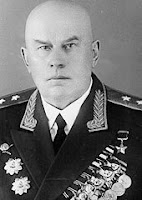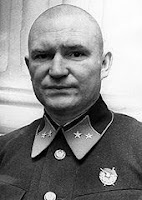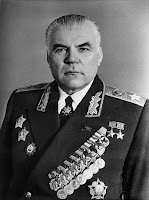It was active during the Winter War against Finland as part of the Leningrad Military District, beginning operations at the end of November 1939 under KomKor M.P. Duhanov with the 49th and Special Rifle Corps as well as assigned aviation units.[1] 9th Army was initially tasked with the capture of Kajaani and Oulu.[2] Two divisions attached to the army, the 44th and 163rd Rifle Divisions, were defeated by the Finns during the Battle of Suomussalmi. It appears to have been disbanded after the end of the war.
Second formation
In 1940 the Army was created to take part in the Soviet occupation of Bessarabia and Northern Bukovina. It was disbanded on 10 July 1940.
Third formation
By 1941 the Army was designated the 9th Separate Army (briefly) and included the 14th, 35th and 48th Rifle Corps (the last under then General Major Rodion Malinovsky), 2nd Cavalry Corps, 2nd and 18th Mechanised Corps, 80th, 81st, 82nd, 84th, 86th Fortified Regions and a number of other units - the biggest army on the Soviet border before the German Operation Barbarossa began. However, it was more an administrative than an operational formation on 22 June 1941.[3] With General Major M.V. Zakharov as chief of staff,[4] it was tasked to cover the Beltsa, Kishinev, and Odessa approaches as part of General Ivan Tyulenev’s Southern Front.
The first engagement came when Von Schobert’s Eleventh Army crashed into the juncture of 9th and 18th Armies. North of Jassy, the German assault fell on the 48th Rifle Corps which was covering Beltsa. Tyulenev ordered a counterattack, and soon 48th Rifle and 2nd Cavalry Corps plus 2nd Mechanised Corps from Southern Front reserve were engaged at Beltsa and Stefanesti. Tyulenev then drew off 25th, 51st, and 150th Rifle Divisions from two of Zakharov’s rifle corps to form a new ‘Coastal Group’ to cover the eastern bank of the Prut River, the northern bank of the Danube and the Black Sea coast.[5] (This group later became the Separate Coastal Army).
By early August, 9th Army was falling back to Nikolayev under repeated German blows, and by 17 August across the River Ingulets and over to the eastern bank of the Dnieper. The ‘Coastal Group’ was meanwhile falling back on Odessa. By early 9 October Army was falling back on Taganrog, after a failed attempt by Southern Front's three armies to hold a line between Pavlograd and the Sea of Azov had been shattered by an outflanking maneuver by Von Kleist's newly renamed First Panzer Army.[6] The resulting Battle of the Sea of Azov shattered 9th Army, virtually destroying it.
The Soviets’ next move was a planned offensive orchestrated by Timoshenko, GlavKom Southwest. After still more retreats and the loss of Rostov, 9th Army stepped off on 17 November as part of an assault by both Southern and Southwestern Fronts, and by 29 November, 9th Army in conjunction with 56th Army and other units had cleared Rostov and the city was back in Soviet hands. 9th Army then joined Timoshenko's strategic reserve, to join the battle again when the Barvenkovo–Lozovaya Offensive operation began.[7] 9th Army joined this assault in January 1942 when it broke into the German front on the northern Donets along with 6th and 57th Armies, reaching the line Balakleya-Lozovaia-Slavyansk before being halted by repeated German counterattacks.
Still with Southern Front, 9th Army was then allotted a subsidiary part in the Kharkov offensive – the Second Battle of Kharkov – which kicked off in May 1942. Along with 57th Army, 9th Army was tasked to secure the southern part of the Izyum bulge in the front. While being in a secondary sector, 9th Army took much of the force of the German response, Operation Fridericus.[8] Eight hours into the German counterstroke, at noon on 17 May, elements of the First Panzer and Seventeenth Armies were ten miles into 9th Army's positions and threatening the neighbouring 57th Army's rear. Commander, Southern Front, General Lieutenant R. Ya. Malinovskii, at once drew 5th Cavalry Corps, a rifle division, and a tank brigade out of reserve in an attempt to halt Von Kleist. However discussions and decisions at Stavka about breaking off the Kharkov offensive in response did not come quickly enough, and 6th and 57th Armies were surrounded in the Izyum pocket with the loss of 200,000 plus men in casualties alone.
Later, as part of the North Caucasian and Transcaucasian Fronts, the Army fought on the big bend of the river Don (in the summer of 1942), and participated in the Battle of the Caucasus.
In November 1943 the army headquarters was disbanded, and its formations and units transferred to other armies.
Active 1939–1945
Engagements
Operation Munchen
Battle of Rostov
Second Battle of Kharkov
Battle of the Caucasus
Commanders
Commander Mikhail Dukhanov, 21 November to 22 December 1939
Commander Vasily Chuikov, 22 December 1939 to 5 April 1940
 |
| Vasily Chuikov |
Lieutenant General Ivan Boldin, 20 June to 10 July 1940
 |
| Ivan Boldin |
Colonel General Yakov Cherevichenko, 22 June to 9 September 1941
 |
| Yakov Cherevichenko |
Major General Fyodor Kharitonov, 9 September 1941 to 20 May 1942
Major General Pyotr Kozlov, 20 May to 18 June 1942
Major General Dmitry Nikishov, 18–24 June 1942
Lieutenant General Anton Lopatin, 24 June to 17 July 1942
 |
| Anton Lopatin |
Major General Theophan Parkhomenko, 14 July to 7 August 1942
Major General Vladimir Marcinkiewicz, 8 to 28 August 1942
Major General Konstantin Koroteev, September 1942 to February 1943
 |
| Konstantin Koroteev |
Major General Vasily Glagolev, 11 February to 22 March 1943
 |
| Vasily Glagolev |
Lieutenant General Konstantin Koroteev, March to May 1943
Major General Aleksei Grechkin, June to November 1943
 |
| Aleksei Grechkin |
Army Troops
14th Rifle Corps - Major General E.G. Egorov
25th Rifle Division - Col. A.S. Zakharchenko
51st Rifle Division - Mj.Gen. P.G. Tsirul’nikov
35th Rifle Corps - Major General I.F. Dashichev
95th Rifle Division - Mj.Gen. A.I. Pastrevich
176th Rifle Division - Mj.Gen. V.M.Martsinkevich
48th Rifle Corps - Major General Rodion Malinovsky
 |
| Rodion Malinovsky |
30th Mountain Division - Mj.Gen. S.G. Galaktionov
74th Rifle Division - Col. F.Ye. Sheverdin
150th Rifle Division - Mj.Gen. I.I. Khorun
2nd Cavalry Corps - Major General Pavel Alexeyevich Belov
 |
| Pavel Belov |
5th Cavalry Division - Col. V.K. Baranov
9th Cavalry Division - Col. A.F. Bychkovsky
2nd Mechanized Corps - Major General Y.V. Novoselsky
11th Tank Division - Col. G.I. Kuzmin
16th Tank Division - Col. M.I. Mindro
15th Motor Rifle Division - Col. N.N. Belov
18th Mechanized Corps - Major General P.V. Volokh
44th Tank Division - Col. V.P. Krimov
47th Tank Division - Col. G.S. Rodin
218th Motor Rifle Division - Mj.Gen. F.N. Shilov
20th Mixed Aviation Division
21st Mixed Aviation Division
45th Mixed Aviation Division
65th Fighter Aviation Division (forming)
66th Fighter Aviation Division (forming)




No comments:
Post a Comment